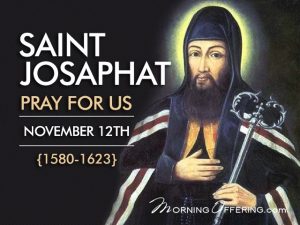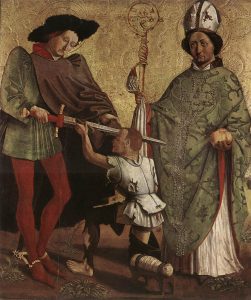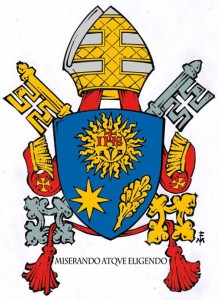 St. Josaphat (1580-1623) was born to a devout religious family of Ruthenian ancestry in what is now Ukraine, and was baptized in the Eastern Orthodox Church. He devoted his virginity to the Virgin Mary and grew in his reverence for ancient liturgy. During a revival of Eastern Catholic monastic life he became a monk in the Order of St. Basil, and was ordained to Holy Orders in the Ukrainian Greek Catholic Church in 1609. He was noted for his life of asceticism, holiness, and virtue which led to his appointment as Archbishop of Polotsk in what is today Belarus. During his lifetime there was much sociopolitical and ecclesiastical rivalry between the Catholics and Orthodox and the Latin and Byzantine rites, especially in the wake of the 1596 Union of Brest which saw the Ruthenian Church break with Orthodox and place itself under the authority of the Holy See. St. Josaphat was passionate about working for the reunification with Rome and won many heretics and schismatics back to communion with the Holy See. However, he was also strongly opposed to the Latinization of his people. This combination of views drew ire from both Catholic and Orthodox clergy. His diocese was contested by the Orthodox, and a rival Orthodox bishop was set up to oppose him, causing riots. During one uprising Josaphat tried to calm the tensions and work for reunification and peace, but his enemies plotted to kill him. A mob of Orthodox Christians entered Josaphat’s home, stabbed and axed his body and threw it into a river. His body was seen glowing in the water and was recovered, and after his martyrdom many miracles were attributed to his intercession. Josaphat’s sacrifice became a blessing as regret and sorrow over his death converted many hearts toward reunification with Rome. In 1867, Josaphat became the first saint of the Eastern Church to be formally canonized by Rome. His feast day is November 12.
St. Josaphat (1580-1623) was born to a devout religious family of Ruthenian ancestry in what is now Ukraine, and was baptized in the Eastern Orthodox Church. He devoted his virginity to the Virgin Mary and grew in his reverence for ancient liturgy. During a revival of Eastern Catholic monastic life he became a monk in the Order of St. Basil, and was ordained to Holy Orders in the Ukrainian Greek Catholic Church in 1609. He was noted for his life of asceticism, holiness, and virtue which led to his appointment as Archbishop of Polotsk in what is today Belarus. During his lifetime there was much sociopolitical and ecclesiastical rivalry between the Catholics and Orthodox and the Latin and Byzantine rites, especially in the wake of the 1596 Union of Brest which saw the Ruthenian Church break with Orthodox and place itself under the authority of the Holy See. St. Josaphat was passionate about working for the reunification with Rome and won many heretics and schismatics back to communion with the Holy See. However, he was also strongly opposed to the Latinization of his people. This combination of views drew ire from both Catholic and Orthodox clergy. His diocese was contested by the Orthodox, and a rival Orthodox bishop was set up to oppose him, causing riots. During one uprising Josaphat tried to calm the tensions and work for reunification and peace, but his enemies plotted to kill him. A mob of Orthodox Christians entered Josaphat’s home, stabbed and axed his body and threw it into a river. His body was seen glowing in the water and was recovered, and after his martyrdom many miracles were attributed to his intercession. Josaphat’s sacrifice became a blessing as regret and sorrow over his death converted many hearts toward reunification with Rome. In 1867, Josaphat became the first saint of the Eastern Church to be formally canonized by Rome. His feast day is November 12.
Month: November 2016
St Martin of Tours
 “Martinmass”
“Martinmass”
John Clare written on 11 Nov 1841.
‘Tis Martinmass from rig to rig
Ploughed fields and meadow lands are blea
In hedge and field each restless twig
Is dancing on the naked tree
Flags in the dykes are bleached and brown
Docks by its sides are dry and dead
All but the ivy-boughs are brown
Upon each leaning dotterel’s headCrimsoned with awes the awthorns bend
O’er meadow-dykes and rising floods
The wild geese seek the reedy fen
And dark the storm comes o’er the woods
The crowds of lapwings load the air
With buzes of a thousand wings
There flocks of starnels too repair
When morning o’er the valley springs
Br Victor-Antoine d’Avila-Latourrette publishes “Christ the Merciful”
 Brother Victor-Antoine d’Avila-Latourrette explores the absolute centrality of Christ in the prayer life of any Christian. The end result is a comprehensive confession of his faith and testimony to the many “names of Christ” that cross through historical, monastic, and mystical traditions. Keeping true to the hope for a unified Church, Christ the Merciful incorporates both Western and Eastern Orthodox sources.
Brother Victor-Antoine d’Avila-Latourrette explores the absolute centrality of Christ in the prayer life of any Christian. The end result is a comprehensive confession of his faith and testimony to the many “names of Christ” that cross through historical, monastic, and mystical traditions. Keeping true to the hope for a unified Church, Christ the Merciful incorporates both Western and Eastern Orthodox sources.
Chapters situating Christ in context of his life in Palestine, his role as a son, friend, and family member, and his place in the living history of the church all help to create a full, well-rounded portrait of his divine and human lives. By viewing Christ through these various facets, the book helps readers enrich their relationship to the mystery of God, adding contour to their spiritual journey.
Brother Victor-Antoine makes difficult concepts clear in a straightforward manner, informed by years of Benedictine monastic practice.
Dedication of St John Lateran Basilica
The Basilica of Saint John Lateran is the cathedral church of the Bishop of Rome, the Pope, and not Saint Peter’s Basilica as many would think. The Liturgy given to us is the feast of the Dedication of the Lateran Basilica because it is the oldest and highest ranking of the four major basilicas in Rome. The Lateran is the oldest church in the West, constructed in the era of the Emperor Constantine and consecrated by Pope Sylvester in AD 324.
What do we celebrate with this feast? We don’t celebrate a building as magnificent as it is; we don’t honor the craftsmanship of the building as important and relevant as this idea is because of beauty and harmony in themselves. But, we do recognize as Pope Benedict XVI said on this feast in 2008: “The beauty and harmony of the churches, destined to give praise to God, also draws us human beings, limited and sinful, to convert to form a “cosmos,” a well-ordered structure, in intimate communion with Jesus, who is the true Saint of saints. This happens in a culminating way in the Eucharistic liturgy, in which the “ecclesia,” that is, the community of the baptized, come together in a unified way to listen to the Word of God and nourish themselves with the Body and Blood of Christ. From these two tables the Church of living stones is built up in truth and charity and is internally formed by the Holy Spirit transforming herself into what she receives, conforming herself more and more to the Lord Jesus Christ. She herself, if she lives in sincere and fraternal unity, in this way becomes the spiritual sacrifice pleasing to God.” Hence, we honor the fact that Jesus Christ through his Apostles and disciples founded a church for our salvation and the proper teaching of the Christian Gospel.
Again Benedict said: “God’s desire to build a spiritual temple in the world, a community that worships him in spirit and truth (cf. John 4:23-24). But this observance also reminds us of the importance of the material buildings in which the community gathers to celebrate the praises of God. Every community therefore has the duty to take special care of its own sacred buildings, which are a precious religious and historical patrimony. For this we call upon the intercession of Mary Most Holy, that she help us to become, like her, the “house of God,” living temple of his love” (November 9, 2008).
A feast with a universal observance, the Church tells us that the archbasilica, the ecclesiastical mother church, called “the mother and mistress of all churches of Rome and the world” (omnium urbis et orbis ecclesiarum mater et caput).
Saint Bernard, Sermon for the Dedication of a Church gives a particular insight into what we do liturgically:
Today’s feast, brothers, ought to be all the more devout as it is more personal. For other celebrations we have in common with other ecclesiastical communities, but this one is proper to us, so that if we do not celebrate it nobody will. It is ours because it concerns our church; ours because we ourselves are its theme. You are surprised and even embarrassed, perhaps, at celebrating a feast for yourselves. But do not be like horses and mules that have no understanding. Your souls are holy because of the Spirit of God dwelling in you; your bodies are holy because of your souls and this building is holy because of your bodies.
Our Christian Object of Faith
Today gave me the opportunity to read through some things today that I have put on the back burner. You can see why I would post this thinking. One such item includes the following:
“The Christian faith has only one object: the mystery of Christ dead and risen. But this unique mystery subsists under different modes: it is prefigured in the Old Testament, it is accomplished historically in the earthly life of Christ, it is contained in mystery in the sacraments, it is lived mystically in souls, it is accomplished socially in the Church, it is consummated eschatologically in the Heavenly Kingdom. Thus the Christian has at his disposition several registers, a multi-dimensional symbolism, to express this unique reality. The whole of Christian culture consists in grasping the links that exist between Bible and Liturgy, Gospel and Eschatology, Mysticism and Liturgy. The application of this method to Scripture is called spiritual exegesis; applied to liturgy it is called mystagogy. This consists in reading in the rites the mystery of Christ, and in contemplating beneath the symbols the invisible reality.”
Jean Cardinal Danielou, SJ
Will we be protagonists or followers?
“The apathy that characterizes our time does not originate in the political process, nor does it confine itself to politics. Its source is quite different; we are dealing with a crisis of the person.”
In the very few days leading up to the US presidential elections we need to stay focussed on the essential matters at hand and not to be distracted by incidental. Hence, our call right now is to make a fervent prayer to the Holy Spirit.
Additionally, I would encourage you to read this 2 page reflection “protagonists-of-our-history.”
Nothing will satisfy us, as Father Giussani reminds, but the desire to be with God who is Father, Son and Holy Spirit.
Attend!
Pope Francis’ Prayer Intentions for November
 The November Prayer Intentions of the Holy Father
The November Prayer Intentions of the Holy Father
Universal Intention
That the countries which take in a great number of displaced persons and refugees may find support for their efforts which show solidarity.
Evangelization Intention
That within parishes, priests and lay people may collaborate in service to the community without giving in to the temptation of discouragement.